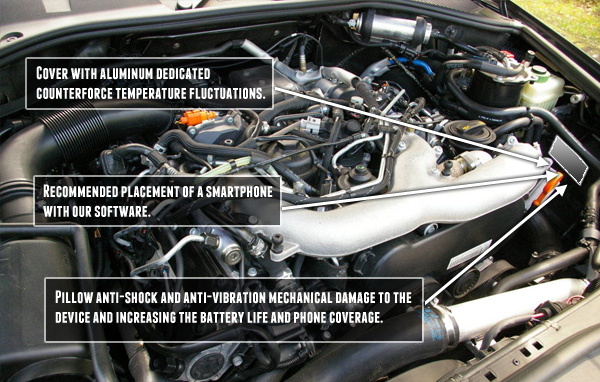
Volkswagen Touareg Mk1 GPS Tracking
Track your Touareg Mk1 for free and visualize it on map
Produced to: 2010
How to track your favourite Volkswagen - model Touareg Mk1 in realtime for free ?
Producer remarks about this particular model
Volkswagen Touareg and was presented in 2002 at the Motor Show in Paris. The car was designed in collaboration with Porsche belonging to the Volkswagen Group, which produces twin model Porsche Cayenne.W 2006 for living in Paris appeared in a modernized variant of the Touareg, which has been styling changes: changed the headlights, front and rear and added a chrome radiator grille. In the same year 40 miles from London took the action called Touareg tows a Boeing 747 Auto-engined V10 TDI by 150 m to tow 155-ton jet. In the car, the weight of the car increased to 7030 kg.Our product description
We are offering you completely free of charge our GPS car tracking solution in real time. The only thing you need to do is to install smartphone with Android inside your vehicle with our awesome application on board
If you want to track your Volkswagen Touareg Mk1 in real time you have to do the following :
1. Download Free Car Tracking Application for Touareg Mk1 application from Google Play
2. Create free account on spysat.eu (for example johndoe) - here is detailed instruction
3. Define Device endpoint for each vehicle you want to track - give friendly name of your Touareg Mk1 and PIN (some random will be provided - you can change it if you want)
4. Run SpySat mobile application on the smartphone and type there your LOGIN from SpySat (ex. johndoe) and PIN (from point 3.)
5. Install your smartphone inside the car
6. Enjoy watching position of your car at spysat.eu site.
7. Provide stable power supply - spysat app consumes some energy.
Best options to install smartphone inside Volkswagen Touareg Mk1

Our engineers together with engineers from Volkswagen developed an optimal place we should put a tracking device. The device should be packaged in a special case. It is protected against mechanical shock and sudden temperature changes. An important element is the airbag anti-shock eliminates most dangerous vibrations.
To permanently mount a smartphone in your Volkswagen Touareg Mk1, follow these steps:1. Find a suitable mounting bracket or adhesive surface for your phone. You can purchase one from an auto store or make your own using materials like rubber or plastic.
2. Clean the surface inside the glove compartment or anywhere else you plan to mount your phone. Remove any dirt or dust that may cause residue when attaching the phone.
3. Align your smartphone with the mounting bracket or adhesive surface and press firmly onto the surface. Ensure it is securely attached without any gaps.
4. Connect your phone to the OBD2 port using an adapter, if desired. This will allow you to use the vehicle's data stream for diagnostics and other features.
5. Install a GPS tracker app of your choice on your smartphone. We recommend our free app available through this website. The app should provide a reliable connection with minimal latency and be optimized for this particular car model.
6. Familiarize yourself with the maintenance tips specific to your Volkswagen Touareg Mk1 model. These may include regular oil changes, tire rotations, and brake inspections to keep your vehicle in good condition.
Remember that permanent mounting of your phone may affect its functionality or appearance, so consider these factors carefully before proceeding.
Users opinions and questions
Frequently Asked Questions:
How does the hydraulic clutch system work in a Volkswagen Touareg Mk1 and what are some common issues that technicians encounter with it during maintenance or repairs?
The hydraulic clutch system in a Volkswagen Touareg Mk1 operates using the following components: master cylinder, slave cylinder, clutch line, release bearing, and clutch disc. Here's how it works:When you press down on the clutch pedal, you are actually pressing down on the master cylinder, which pushes hydraulic fluid into the clutch line. This fluid then travels to the slave cylinder, where it forces a piston to move. The movement of the piston in the slave cylinder results in the release bearing pulling away from the pressure plate and flywheel, allowing the clutch disc to disengage from the transmission.
When you release the clutch pedal, the master cylinder creates a vacuum, causing hydraulic fluid to return to it and relieving pressure on the slave cylinder. This allows the release bearing to push against the pressure plate and flywheel, re-engaging the clutch disc with the transmission.
Some common issues that technicians encounter with the hydraulic clutch system in a Volkswagen Touareg Mk1 include:
1. Leaks: Clutch lines can develop leaks over time, causing fluid loss and ultimately leading to difficulty engaging or disengaging the clutch pedal.
2. Worn parts: The clutch disc, release bearing, and pressure plate can wear out over time, causing slippage when attempting to shift gears. This can lead to transmission damage if left unaddressed.
3. Master cylinder failure: If the master cylinder fails, it may not be able to create enough pressure to engage or disengage the clutch pedal properly.
4. Slave cylinder issues: The slave cylinder can develop leaks or become stuck due to debris, causing difficulty in engaging or disengaging the clutch pedal.
5. Air in the system: If air enters the hydraulic clutch system, it can cause a spongy feel when pressing down on the clutch pedal and may lead to slippage when shifting gears.
How does the Volkswagen Touraeg Mk1's permanent 4x4 system function and what are its specifications for off-road capability?
The Volkswagen Touareg Mk1 (2002-2010) features a permanent all-wheel drive (4Motion) system, which is designed to provide exceptional traction and handling in various driving conditions. This advanced 4x4 technology consists of a Haldex clutch, which can vary the torque distribution between the front and rear wheels according to the driving conditions. In normal situations, around 90% of the power is sent to the front wheels, while the remaining 10% goes to the rear ones.When the road surface becomes slippery or uneven, the system automatically transfers more torque to the rear wheels, providing better traction and stability. The Haldex clutch can react quickly, taking less than 250 milliseconds to change the power distribution between the axles. This allows the Touareg Mk1 to maintain a smooth driving experience even on challenging terrains.
The off-road capability of the Touareg Mk1 is further enhanced by its ground clearance, approach and departure angles, and various drive modes. With a maximum ground clearance of 205 mm (8.1 inches), the Touareg can handle rough terrain without any issues. The approach angle is 27 degrees, while the departure angle stands at 24 degrees, ensuring that the vehicle can tackle steep inclines and descents with ease.
In addition to the standard drive mode, the Touareg Mk1 also offers an off-road mode, which adjusts the throttle response, transmission shifting, and stability control settings to provide better traction and control in challenging conditions. The Hill Descent Control system is also available, allowing the driver to maintain a constant speed when descending steep slopes without having to constantly apply the brakes.
The Touareg Mk1's off-road capability is further enhanced by its advanced suspension system, which includes a multi-link setup at the rear and either a McPherson strut or a multi-link design at the front, depending on the engine option. This allows the vehicle to maintain a stable ride quality even when navigating uneven surfaces.
In summary, the Volkswagen Touareg Mk1's permanent 4x4 system is designed to provide exceptional traction and handling in various driving conditions. Its Haldex clutch can vary the torque distribution between the front and rear wheels according to the road surface, ensuring a smooth and stable driving experience even on challenging terrains. With its ground clearance, approach and departure angles, and various drive modes, the Touareg Mk1 is well-equipped for off-road adventures.
Can you explain the differences between the 2.0L TDI and 1.8T engines in terms of performance, fuel efficiency, and maintenance requirements for a potential Volkswagen Touraeg Mk1 buyer?
The Volkswagen Touareg Mk1 was produced from 2002 to 2007 and came with two main engine options - the 2.0L TD (Turbo Diesel) and the 1.8T (Turbocharged). Here are some key differences between these engines:Performance: The 2.0L TD engine produces around 150 horsepower and 236 lb-ft of torque, while the 1.8T engine has a power output of around 220 horsepower and 225 lb-ft of torque. The 1.8T engine is therefore more powerful and provides better performance.
Fuel Efficiency: Both engines have their own strengths and weaknesses when it comes to fuel efficiency. The 2.0L TD engine is known for its fuel efficiency, providing around 17-20 mpg in the city and 23-26 mpg on the highway. However, the 1.8T engine, being a turbocharged petrol engine, consumes more fuel, with estimated fuel economy of around 15-17 mpg in the city and 21-24 mpg on the highway.
Maintenance Requirements: Both engines have their own maintenance requirements that should be taken into account before making a decision. The 2.0L TD engine is generally considered more reliable, with less frequent oil changes (around every 15,000 miles) and fewer issues reported by owners. However, the engine does require a specific type of fuel (diesel) which can be more expensive in some areas. On the other hand, the 1.8T engine requires more frequent oil changes (every 7,500 miles) and can experience common issues such as turbocharger failure, injector problems and timing chain issues.
In summary, if fuel efficiency and reliability are your top priorities, then the 2.0L TD engine is a good choice. However, if you prioritize performance and don't mind higher maintenance costs, then the 1.8T engine may be the better option for you. It is always recommended to consult with a Volkswagen specialist or mechanic before making a decision on which engine would best suit your needs.
How should I properly replace the air filter in my Volkswagen Touareg Mk1 to prevent any potential engine performance issues?
Replacing the air filter on your Volkswagen Touareg Mk1 is a simple process that can be done at home with basic tools. Here's how:1. Locate the air filter housing - The air filter housing is typically located in the engine compartment, usually near the top of the engine. It may have a black or silver cover with a rubber gasket around it. Remove the old air filter - Open the hood and locate the air filter housing. Remove the screws or clips holding the cover in place and remove the old air filter. Note that the Touareg Mk1 uses a round, pleated filter element. Clean the air filter housing - Use a soft-bristled brush to gently clean the inside of the air filter housing, removing any debris or dust that has accumulated. Be careful not to scratch the interior surfaces. Install the new air filter - Place the new air filter into the housing, ensuring that it is properly seated and aligned with the gasket around the edges. If necessary, use a screwdriver to gently push the filter into place. Reinstall the air filter cover - Once the new filter is in place, reattach the cover using the screws or clips. Tighten them securely but do not overtighten, as this can damage the gasket. Start the engine and check for leaks - Turn on the engine and let it run for a few minutes to ensure that there are no leaks around the air filter housing. If you notice any signs of leakage, such as smoke or oil, double-check the installation to make sure everything is properly seated. By replacing the air filter regularly (every 12,000 miles or so), you can help prevent engine performance issues caused by a clogged filter. This will also help ensure that your Touareg Mk1 runs smoothly and efficiently over time.